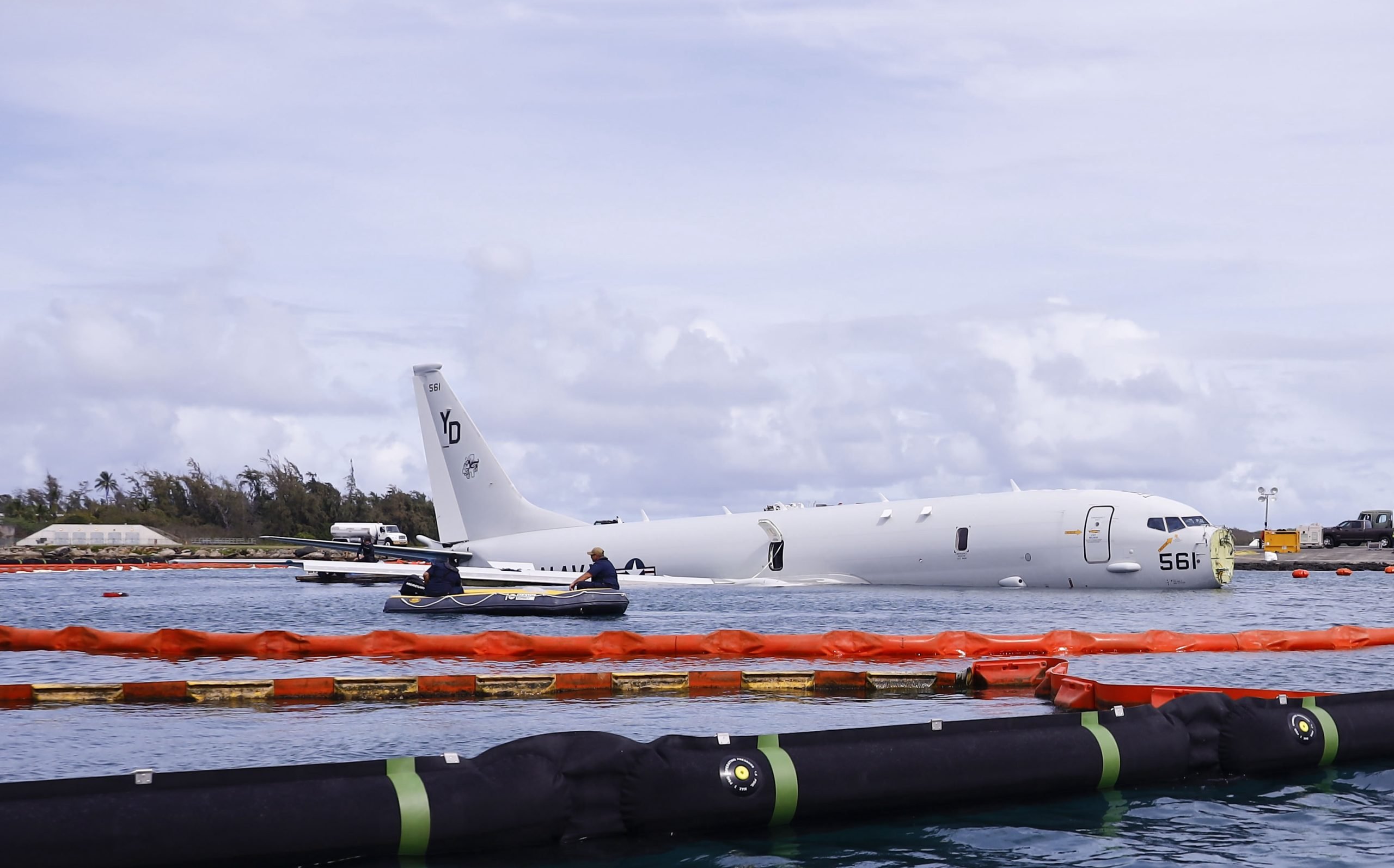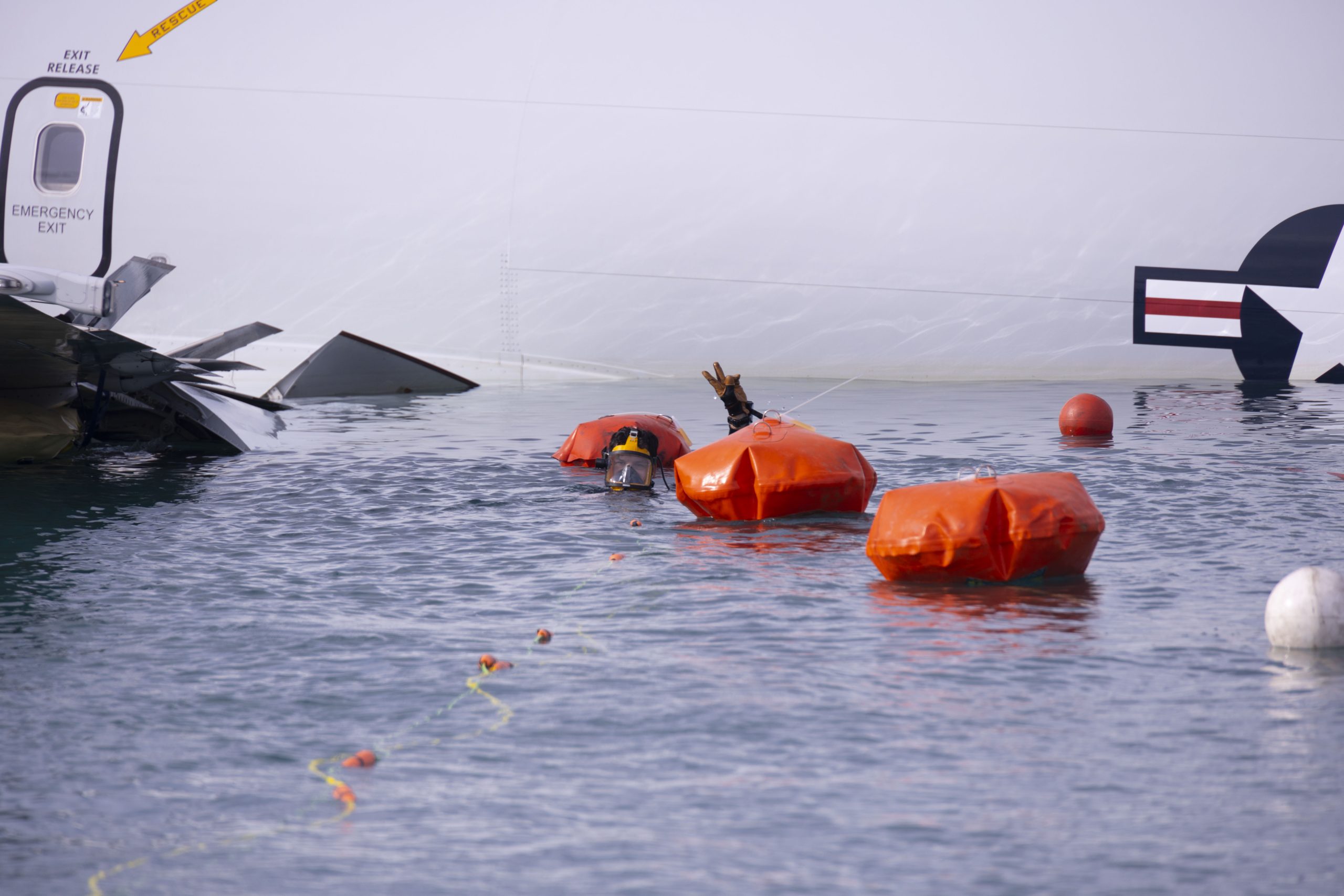Kaneohe Bay Aircraft Coral Assessment, Dec. 3, 2023 from Hawaii DLNR on Vimeo.
SA: Navy confirms P-8A plane successfully removed from Kaneohe Bay | Honolulu Star-Advertiser (staradvertiser.com)
USNI: Navy, Marine Team Recover P-8A from Hawaiian Bay - USNI News
DLNR: DLNR News Release-KĀNEʻOHE BAY REEF DAMAGE ASSESSMENT CONTINUES TODAY , Dec. 4, 2023 (hawaii.gov)
TD: How The Navy Got Its P-8A Poseidon Out Of The Water In Hawaii (thedrive.com)
Navy, USMC Update Efforts to Salvage P-8A Aircraft, Protect Reef
by Gidget Fuentes, USNI News, November 27, 2023
Navy mobile diving and salvage crews spent Sunday emptying the fuel tanks of a Navy P-8A Poseidon airplane that overshot the runway at Kaneohe Bay Marine Corps Air Station in Hawaii last week, officials said Monday.
The Whidbey Island, Wash.-based P-8A had about 2,000 gallons of fuel as it attempted to land on Nov. 20 at the Marine airfield, on Oahu’s northeast windward coast, said Rear Adm. Kevin Lenox, who the Navy assigned as incident commander.
“The team executed a slow and methodological de-fueling process,” Lenox said Monday at a press conference live-streamed from the air station. “This was done to minimize the risk of environmental harm in the follow-on salvage process.”
“The team extracted all the fuel that they could get out of those tanks. This process was completed successfully without any fuel being released into the bay,” he said, and later noted that a P-8A “has never been de-fueled underwater.”
Experts and information at the scene determined that the plane’s fuel system “is still intact,” and no fuel had leaked into the bay, Lenox said. The recovered fuel was tested today and “had no water in it,” he said, noting that “we could put that on another plane and it’d be good to go.”

Three environmental containment booms are deployed as a preventative measure to contain any potential fuel or oil leaks during defueling operations on a downed U.S. Navy P-8A Poseidon in waters just off the runway at Marine Corps Air Station Kaneohe Bay, Marine Corps Base Hawaii, Nov. 26, 2023. US Marine Corps Photo
Lenox, who commands Carrier Strike Group 3, said the team “has been singularly focused on developing a salvage plan for this aircraft that prioritizes the safety of personnel and the environment here in Kaneohe Bay.” State environmental representatives were on site and observed the containment and de-fueling work, he said. He promised better communications with the local community, which has been leery of Navy pronouncements following contamination at Red Hill Bulk Fuel Storage Facility at Joint Base Pearl Harbor-Hickam.
Three Navy pilots along with a crew of two officers and four enlisted personnel with “The Skinny Dragons” of Patrol Squadron (VP) 4 were aboard the P-8A aircraft as it landed at Kaneohe Bay just before 2 p.m. local Hawaii time. For undetermined reasons – the investigations into the cause are underway – the aircraft ran off the runway and into the shallow bay.
While the work continues, the squadron deployed another P-8A maritime patrol and reconnaissance aircraft to Hawaii to pick up the mishap aircrew’s homeland defense mission in support of U.S. 3rd Fleet, Lenox said. That aircraft along with other fixed-wing aircraft at Kaneohe Bay currently are flying missions out of Hickam’s airfield, officials said.
None of the nine people aboard the aircraft – tail number 561 – were injured, officials said.
The aircraft remains intact, and officials said are hopeful that it can be recovered and eventually return to service. The P-8A remained in the bay where it landed, its landing gear intact and the aircraft remaining buoyant, Lenox said.
“Navy divers arrived here within hours and worked quickly to stabilize the aircraft to minimize the risk of a spill,” he said. Next came the work to remove fuel from the aircraft. The divers returned to Joint Base Pearl Harbor-Hickam to familiarize themselves with the Poseidon and the aircraft’s fuel systems, and they practiced connecting and disconnecting the fuel lines, he said, “so they weren’t doing it for the first time in the water.”
That de-fueling work was done with the assistance of Naval Air Systems Command at Patuxent River, Md. After removing the fuel – two tanker trucks arrived early Sunday to receive the fuel – Navy divers then conducted a hydrographic survey to assess the coral and marine environment around the aircraft, which ended up in a shallow part of the bay. “The survey is helping the Navy plan a recovery operation that minimizes impact to the critical ecosystem here in Kaneohe Bay,” said Lenox.
Once the on-scene mishap investigation work is done, the aircraft’s salvage and repair will move into high gear. “We will do everything we can to retain operational capabilities of this aircraft,” Lenox said, later adding that “the aircraft is in remarkably good condition, and has full integrity.”
Investigations will include the naval safety investigation and the command investigation, a legal investigation known as the JAGMAN and guided by the Judge Advocate General’s Manual. “An Aviation Mishap Board is here on site,” he added, and the administrative investigation is led by a senior, experienced maritime patrol and reconnaissance aviator outside the squadron’s chain of command. “The Navy is committed to learning from this investigation, regardless of the cause,” he added.

A sailor with Company 1-3, Mobile Diving and Salvage Unit 1, communicates intentions to dive with fellow team members on shore during defueling operations on a downed U.S. Navy P-8A Poseidon in waters just off the runway at Marine Corps Air Station Kaneohe Bay, Marine Corps Base Hawaii, Nov. 26, 2023. US Marine Corps Photo
Aircraft Intact, Recovery Options
The aircraft is upright in the water, sitting on its landing gear with its left engine resting on coral, officials said.
Cmdr. Mark Anderson, MDSU-1’s commander, said the aircraft is sitting atop coral and sand. “There’s some positive buoyancy there,” with the aircraft moving slightly with the tide. Team that responded to the scene that first day began to assess the stability of the aircraft.
Dive teams have taken underwater images of the aircraft in the bay, which helped in the containment response and in assessments and planning for its recovery and any impact to the coral, Anderson said. Coral damage is believed to be minor, but more imagery is being collected as the assessments continue.
The Navy is exploring two options to remove the P-8A from the bay and restore it to flight.
“Extensive technical analyses from both salvage and aircraft engineering specialists are integrated into developing this plan,” Lenox said. “Our collective goal is to remove the aircraft as soon and as safely as possible.”
The Navy is working to gather equipment “we need to be able to safely lift this out of the bay and onto the runway” without harm to the environment and while preserving the capability of this aircraft, he said.
With the aircraft’s tanks emptied of fuel, salvage and recovering crews are working on two courses of action to get the P-8A back onto land.
One option would be “to float it and get it within range” of a crane at the airfield, Lenox said. If that can be supported, the aircraft would be lifted and moved to the runway, “and it would settle onto its landing gear, which is still in good condition.”
In another option, he said, the aircraft would be floated but then be “rolled” up onto the runway, using cylinder-type bags arriving Wednesday from a company in Louisiana.
Immediate Initial Response
The nine personnel aboard the P-8A Poseidon “safely evacuated on their own,” Col. Jeremy Beaven, commander of Marine Corps Base Hawaii, said during the press conference.
Help arrived on the scene within minutes and moved to aid the crew and to contain any potential leakages of aircraft fuel into the bay, officials said. A “boom boat” with 800 feet of boom was at the crash site “within minutes,” emplacing the first booms within 30 minutes, said Beaven, a veteran naval flight officer commander. Teams used bulldozers on the runway to help secure the P-8A from further movement.
“Coincidentally… three days before the incident, my waterfront operations team was doing a pre-planned drill,” he said. Over those days, “they were on the water here on the bay for several hours, and I was on the boats for close to two hours.”
Those experts were able to step in quickly and assist in that initial response, Beaven said. “It really helped in those initial moments,” he added, noting “our response was quick – within minutes.”
In the days since, he said, the Marine Corps and Navy have continued coordinating through the base’s emergency operations center with local, state and federal agencies to synchronize the response and plans to recover the aircraft and do any remediation to the bay and its coral reefs.
Base teams had quickly deployed containment booms around the aircraft to contain any hazardous fluids like fuel, Beaven said. “Those actions happened right around the 30-minute mark.”
Since then, two additional layers of booms were placed, along with “absorbents” to gather any leakage, he said. Teams with the Navy’s Mobile Diving Salvage Unit 1 arrived from Joint Base Pearl Harbor-Hickam and secured the P-8A to ensure the aircraft didn’t move “and create any further damage to the reef,” he added.
---30---
SA: Navy video shows no widespread reef damage from plane in Kaneohe Bay | Honolulu Star-Advertiser (staradvertiser.com)
SA: Navy plane ‘pulverized’ coral in Kaneohe Bay, state divers say | Honolulu Star-Advertiser (staradvertiser.com)